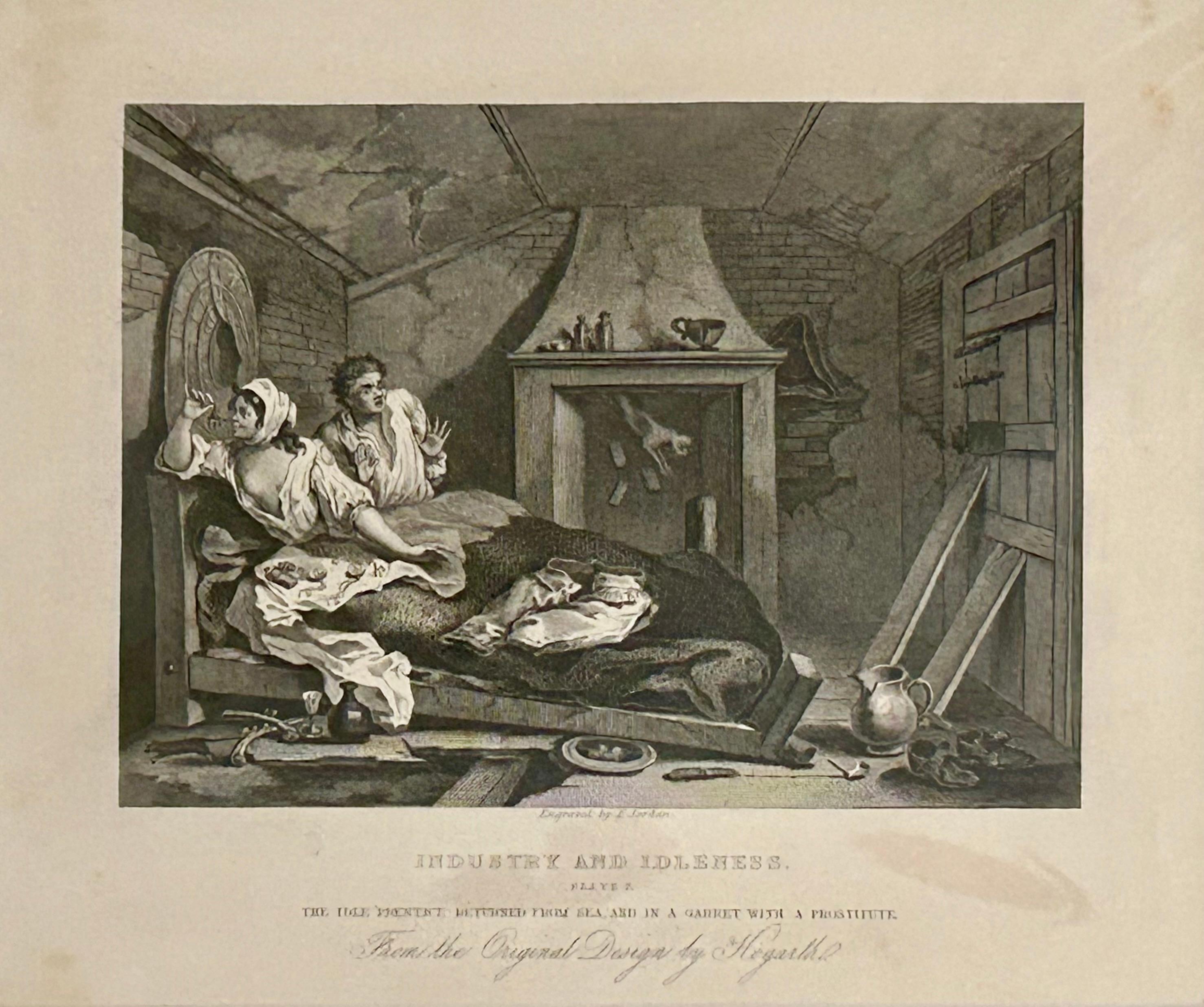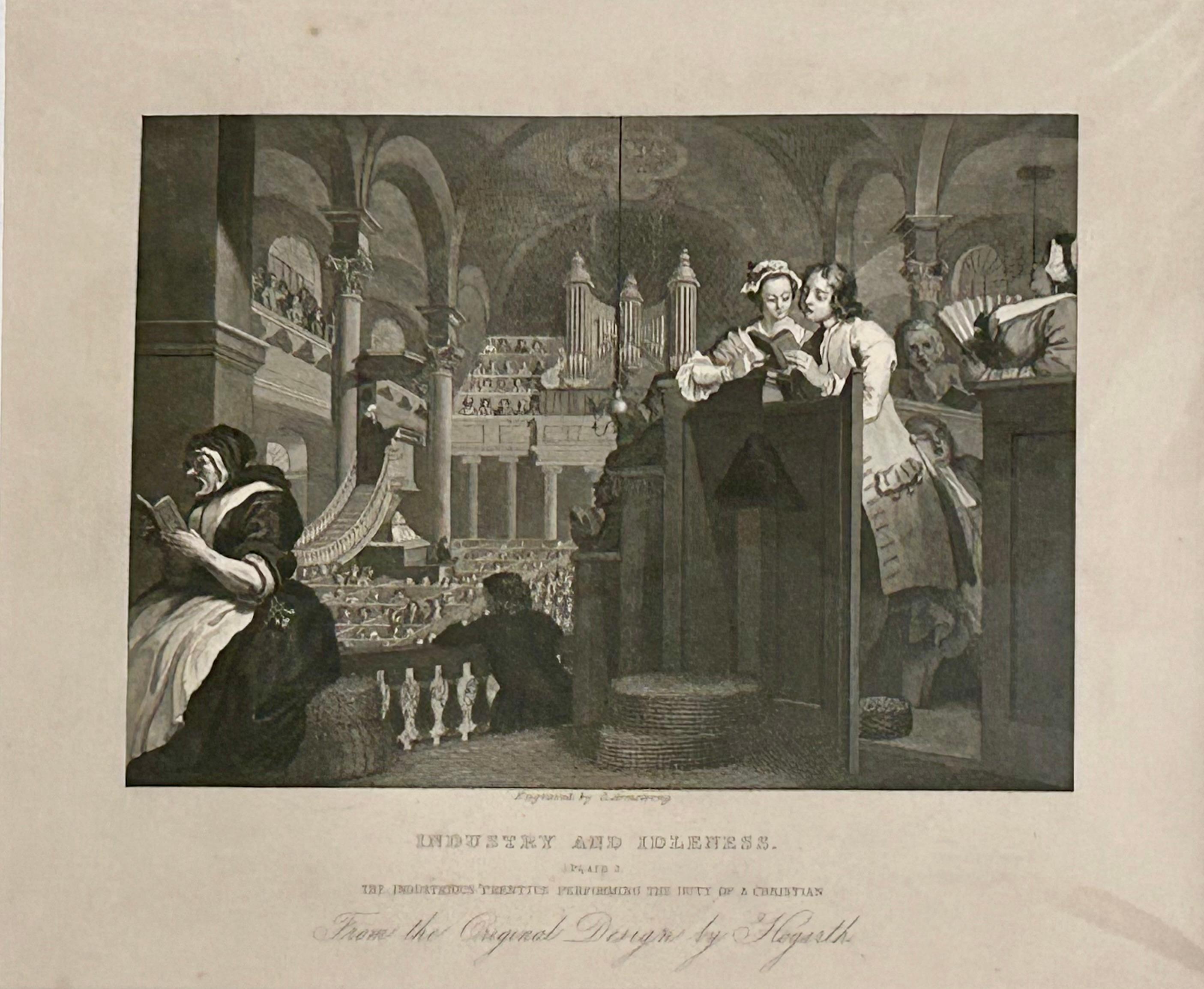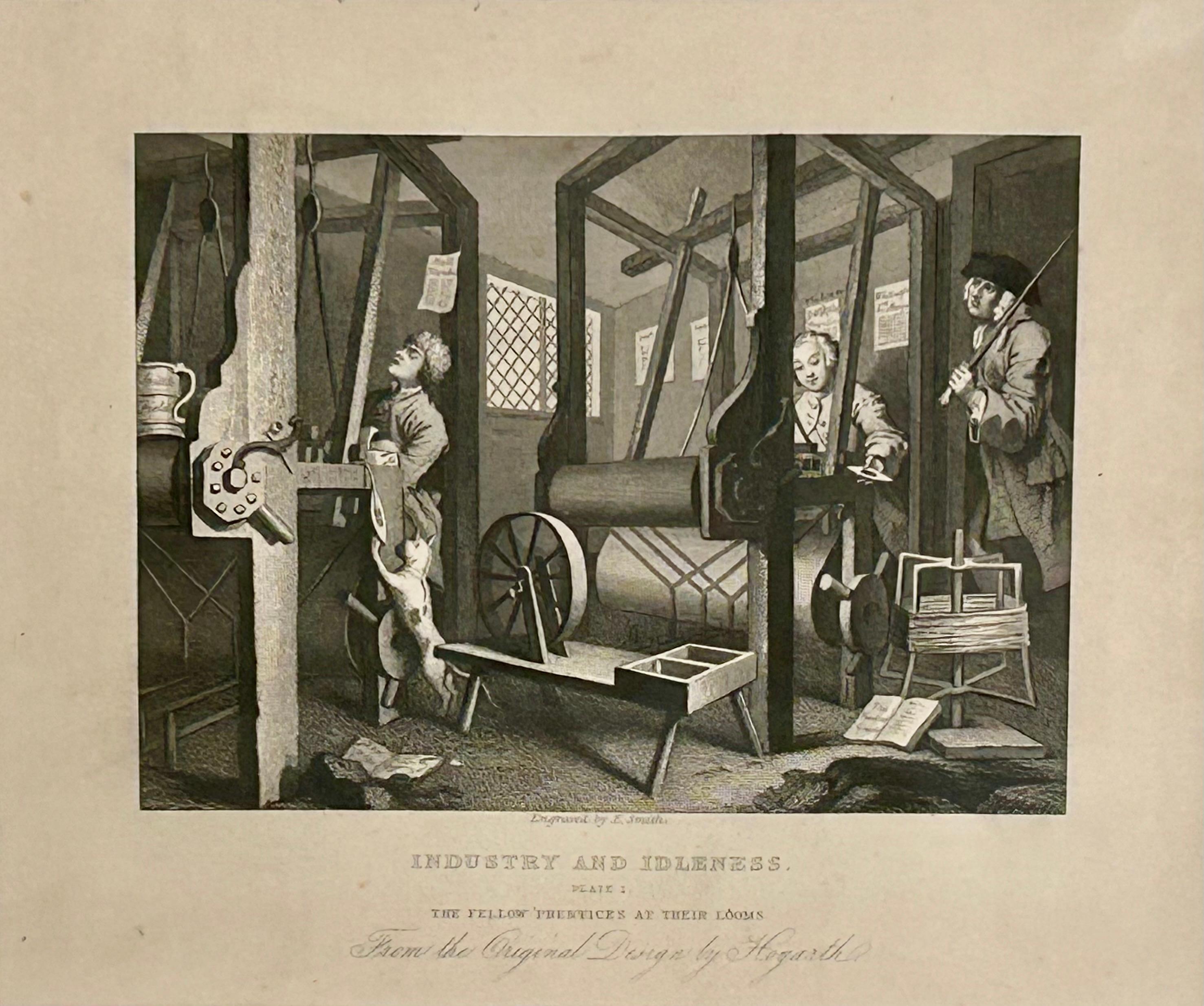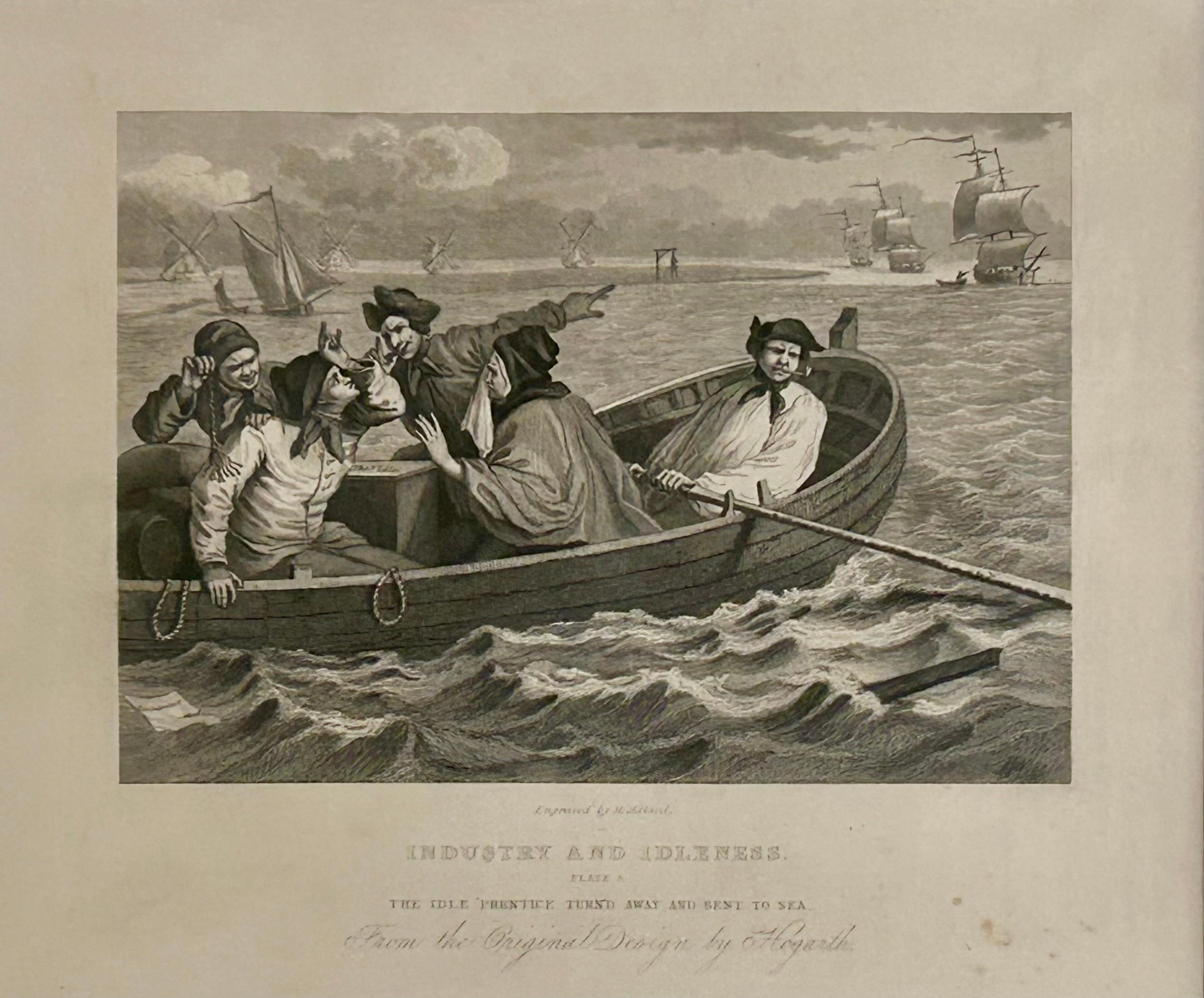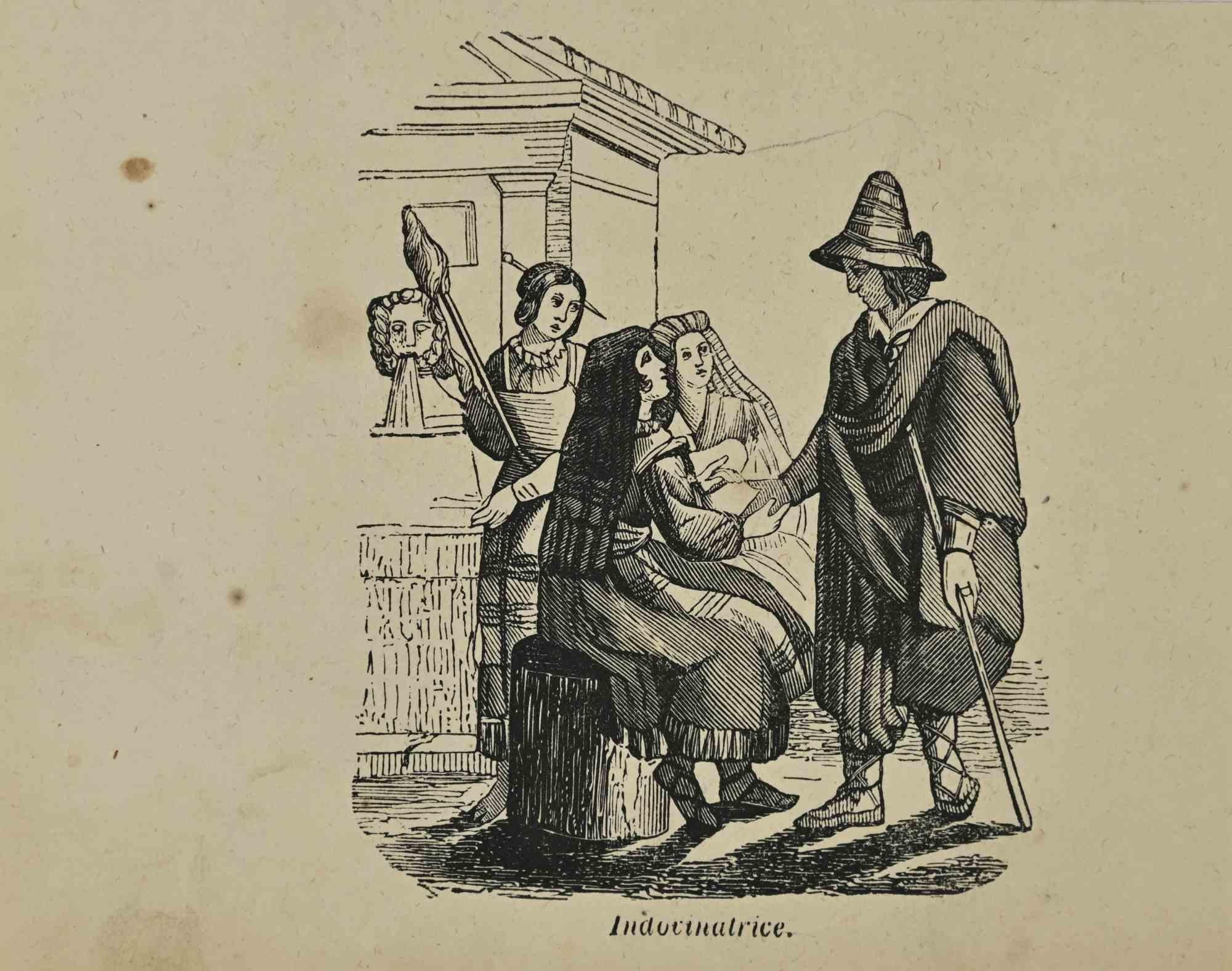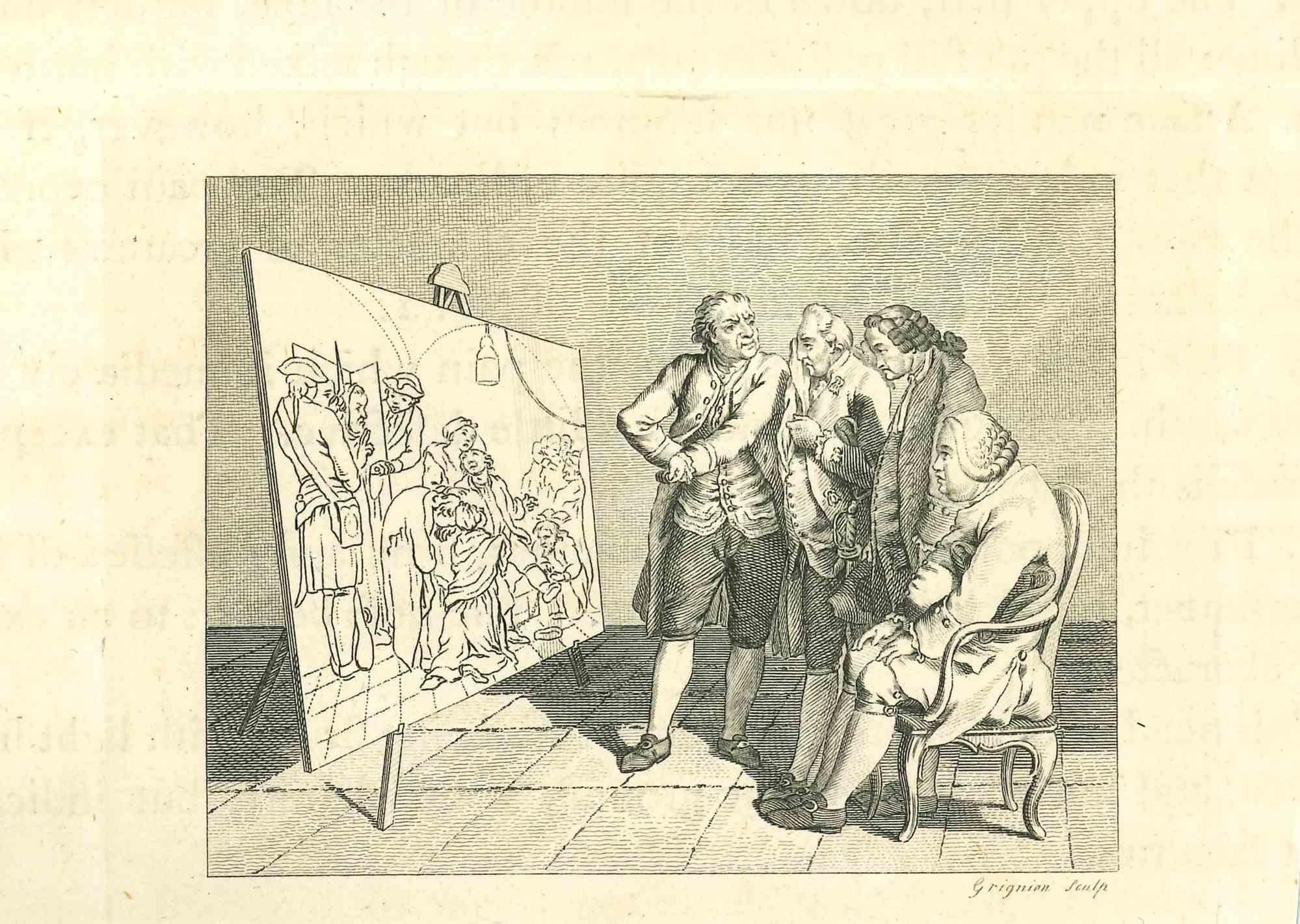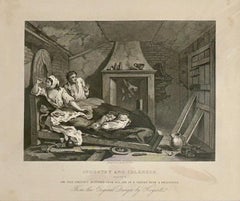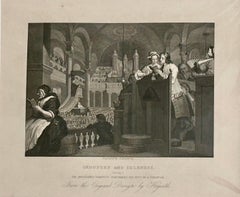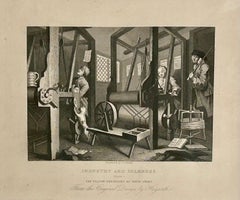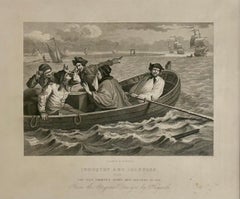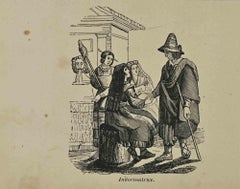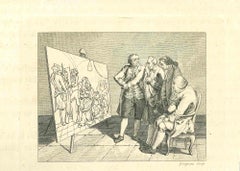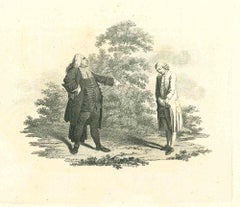Items Similar to Industry and Idleness Plate 3: The Idle 'Prentice at Play In The Church Yard
Want more images or videos?
Request additional images or videos from the seller
1 of 3
Industry and Idleness Plate 3: The Idle 'Prentice at Play In The Church Yard1830
1830
$183.33
$229.1720% Off
£136
£17020% Off
€157.92
€197.4120% Off
CA$256.65
CA$320.8220% Off
A$279.93
A$349.9120% Off
CHF 147.50
CHF 184.3720% Off
MX$3,357.11
MX$4,196.3820% Off
NOK 1,857.20
NOK 2,321.5020% Off
SEK 1,732.73
SEK 2,165.9220% Off
DKK 1,179.42
DKK 1,474.2720% Off
About the Item
William Hogarth was an English painter and engraver, the outstanding British artist of his period. During his childhood, his father, a schoolteacher, was imprisoned for debt, and this early experience of the seamy side of life left a deep mark on Hogarth (much of his output is concerned with the contrast between success and failure, and he depicted prisons in several works). He trained as an engraver of silver plate and by 1720 had set up his own business in London, doing various kinds of commercial work. In his spare time he studied painting, first at the St Martin's Lane Academy and later under Sir James Thornhill, whose daughter he married in 1729. By the early 1730s he had achieved some success as a painter of conversation pieces and at about the same time he invented the idea of using a sequence of anecdotal pictures ‘similar to representations on the stage’ to point a moral and satirize social abuses.
A set of 12 original engravings illustrating Industry and Idleness, after the drawings by William Hogarth, printed in 1833. The engravers are F Jordan, E Smith, C Armstrong, S Davenport, H Adlard, W H Worthington, H Fernell, A Duncan and F F Walker. The engravings, which are in excellent condition, would be mounted (matted) and ready to frame
Edward Smith (fl. 1823-49)
The landscape, figure, and portrait engraver Edward Smith may have been a native of Edinburgh but appears to have worked mostly in London. His earliest recorded plates are for Effigies Poeticae in 1823. He went on to contribute to Hogarth Moralized (1831), Hogarth's Works (1833)
Read moreText source: The Oxford Dictionary of Art and Artists (Oxford University Press)
Engraved from the original by Wm Hogarth
Minor foxing
About the Seller
5.0
Gold Seller
Premium sellers maintaining a 4.3+ rating and 24-hour response times
Established in 2021
1stDibs seller since 2021
39 sales on 1stDibs
- ShippingRetrieving quote...Shipping from: Bournemouth, United Kingdom
- Return Policy
More From This Seller
View AllIndustry and Idleness Plate 7: The Idle 'Prentice Returned From Sea
By William Hogarth
Located in Bournemouth, Dorset
William Hogarth was an English painter and engraver, the outstanding British artist of his period. During his childhood, his father, a schoolteacher, was imprisoned for debt, and th...
Category
1830s Figurative Prints
Materials
Engraving
$183 Sale Price
20% Off
Industry and Idleness Plate 2: The Industrious 'Prentice Performing: Duty
By William Hogarth
Located in Bournemouth, Dorset
William Hogarth was an English painter and engraver, the outstanding British artist of his period. During his childhood, his father, a schoolteacher, was imprisoned for debt, and this early experience of the seamy side of life left a deep mark on Hogarth (much of his output is concerned with the contrast between success and failure, and he depicted prisons in several works). He trained as an engraver of silver plate and by 1720 had set up his own business in London, doing various kinds of commercial work. In his spare time he studied painting, first at the St Martin's Lane Academy and later under Sir James Thornhill, whose daughter he married in 1729. By the early 1730s he had achieved some success as a painter of conversation pieces and at about the same time he invented the idea of using a sequence of anecdotal pictures ‘similar to representations on the stage’ to point a moral and satirize social abuses.
A set of 12 original engravings illustrating Industry and Idleness, after the drawings by William Hogarth, printed in 1833. The engravers are F Jordan, E Smith, C Armstrong, S Davenport, H Adlard, W H Worthington, H Fernell, A Duncan and F F Walker. The engravings, which are in excellent condition, would be mounted (matted) and ready to frame
Edward Smith (fl. 1823-49)
The landscape, figure, and portrait engraver Edward Smith may have been a native of Edinburgh but appears to have worked mostly in London. His earliest recorded plates...
Category
1830s Figurative Prints
Materials
Engraving
$183 Sale Price
20% Off
Industry and Idleness Plate 1: The Fellow 'Prentices at their Looms
By William Hogarth
Located in Bournemouth, Dorset
William Hogarth was an English painter and engraver, the outstanding British artist of his period. During his childhood, his father, a schoolteacher, was imprisoned for debt, and this early experience of the seamy side of life left a deep mark on Hogarth (much of his output is concerned with the contrast between success and failure, and he depicted prisons in several works). He trained as an engraver of silver plate and by 1720 had set up his own business in London, doing various kinds of commercial work. In his spare time he studied painting, first at the St Martin's Lane Academy and later under Sir James Thornhill, whose daughter he married in 1729. By the early 1730s he had achieved some success as a painter of conversation pieces and at about the same time he invented the idea of using a sequence of anecdotal pictures ‘similar to representations on the stage’ to point a moral and satirize social abuses.
A set of 12 original engravings illustrating Industry and Idleness, after the drawings by William Hogarth, printed in 1833. The engravers are F Jordan, E Smith, C Armstrong, S Davenport, H Adlard, W H Worthington, H Fernell, A Duncan and F F Walker. The engravings, which are in excellent condition, would be mounted (matted) and ready to frame
Edward Smith (fl. 1823-49)
The landscape, figure, and portrait engraver Edward Smith may have been a native of Edinburgh but appears to have worked mostly in London. His earliest recorded plates...
Category
1830s Figurative Prints
Materials
Engraving
$183 Sale Price
20% Off
Industry and Idleness Plate 5: The Idle 'Prentice Turn'd Away & Sent to Sea
By William Hogarth
Located in Bournemouth, Dorset
William Hogarth was an English painter and engraver, the outstanding British artist of his period. During his childhood, his father, a schoolteacher, was imprisoned for debt, and this early experience of the seamy side of life left a deep mark on Hogarth (much of his output is concerned with the contrast between success and failure, and he depicted prisons in several works). He trained as an engraver of silver plate and by 1720 had set up his own business in London, doing various kinds of commercial work. In his spare time he studied painting, first at the St Martin's Lane Academy and later under Sir James Thornhill, whose daughter he married in 1729. By the early 1730s he had achieved some success as a painter of conversation pieces and at about the same time he invented the idea of using a sequence of anecdotal pictures ‘similar to representations on the stage’ to point a moral and satirize social abuses.
From a set of 12 original engravings illustrating Industry and Idleness, after the drawings by William Hogarth, printed in 1833. The engravers are F Jordan, E Smith, C Armstrong, S Davenport, H Adlard, W H Worthington, H Fernell, A Duncan and F F Walker. The engravings, which are in excellent condition, would be mounted and ready to frame
Edward Smith (fl. 1823-49)
The landscape, figure, and portrait engraver Edward Smith may have been a native of Edinburgh but appears to have worked mostly in London. His earliest recorded plates...
Category
1830s Figurative Prints
Materials
Engraving
$183 Sale Price
20% Off
Thomas Cooke - The Notorious Islington Miser
Located in Bournemouth, Dorset
This intriguing engraving captures the enigmatic figure of Thomas Cooke, the notorious Islington miser. The portrait showcases his unique sense of fashion, with every detail meticul...
Category
19th Century Figurative Prints
Materials
Engraving
$102 Sale Price
20% Off
An Emblematical Print on the South Sea Bubble
By William Hogarth
Located in Bournemouth, Dorset
William Hogarth was an English painter and engraver, the outstanding British artist of his period. During his childhood, his father, a schoolteacher, was imprisoned for debt, and th...
Category
1830s Figurative Prints
Materials
Engraving
$183 Sale Price
20% Off
You May Also Like
Uses and Customs - Guesser - Lithograph - 1862
Located in Roma, IT
Uses and Customs - Guesser is a lithograph on paper realized in 1862.
The artwork belongs to the Suite Uses and customs of all the peoples of the universe: " History of the governme...
Category
1860s Modern Figurative Prints
Materials
Lithograph
The Physiognomy -The Painting - Original Etching by Thomas Holloway - 1810
By Thomas Holloway
Located in Roma, IT
The Physiognomy -The painting is an original etching artwork realized by Thomas Holloway for Johann Caspar Lavater's "Essays on Physiognomy, Designed to Promote the Knowledge and the...
Category
1810s Modern Figurative Prints
Materials
Etching
After Carington Bowles - 18th Century Engraving, The Prodigal Son Returns
Located in Corsham, GB
A charming engraving depicting the parable of the Prodigal Son in the Bible, found in Luke 15:11-32, after the original painting by Carington Bowles. Inscribed in plate. Presented in...
Category
Early 18th Century Figurative Prints
Materials
Engraving
Historical Scene - Etching by Thomas Holloway - 1810
By Thomas Holloway
Located in Roma, IT
Historical scene is an artwork realized by Thomas Holloway for Johann Caspar Lavater's "Essays on Physiognomy, Designed to promote the Knowledge and the Love of Mankind", London, Be...
Category
1810s Modern Figurative Prints
Materials
Etching
Daily Life In The Roman Empire - Etching - 18th Century
Located in Roma, IT
Daily Life In The Roman Empire from "Antiquities of Herculaneum" is an etching on paper realized by Various Authors in the 18th Century.
Monogrammed on the...
Category
18th Century Old Masters Figurative Prints
Materials
Etching
By Piety's Due Rites tis Given - Etching by Thomas Rowlandson - 1817
By Thomas Rowlandson
Located in Roma, IT
Etching and aquatint realized by Thomas Rowlandson in 1817. Plate from "The Dance of Life" by William Combe.
Very good condition.
Thomas Rowlandson (1757-1827) was an english artis...
Category
Mid-19th Century Modern Figurative Prints
Materials
Etching
More Ways To Browse
Antique Effigy
Basya Wuensch Reiter
Calder Santa Claus
Camille Pissarro Signed
Carlos Merida Silkscreens
Carlos Schwabe
Chagall Coq
Chagall Moses Tablets
Chagall Offset Lithographs
Chagall Paradis
Charles Bragg Signed Prints
Dali Art Of Love
Dali Bird
Dali Don Quixote
Dali Dragon
Dali Le Cavalier
Dali Lithograph Bullfighter
Dali Signed Lithograph Numbered
